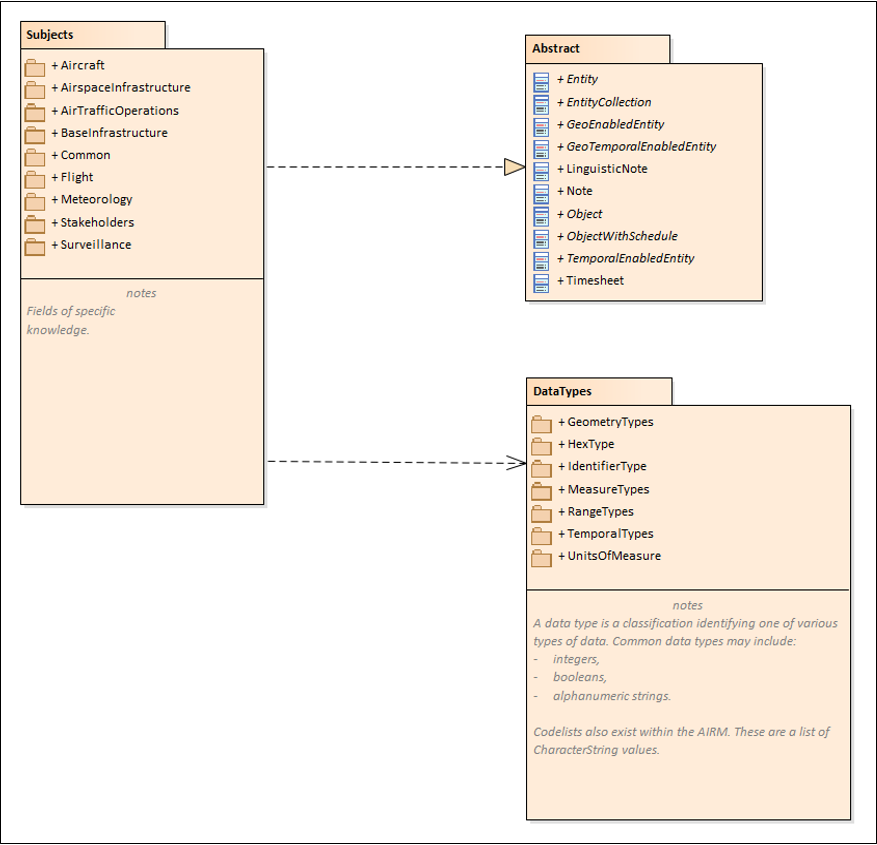AIRM Docs
Details about the AIRM Components
The AIRM Product Structure
The AIRM includes:
- Main content. This content was extracted from ICAO Annexes and Documents as well as specifications and standards that were accepted at the global level.
- Supplements. The supplements elaborate the main content for a particular community. They follow the same structure and rules as the main content. Supplements are part of the reference as their content is of interest to the global ATM Community.
The main content is in three components, moving from a “top-down” ATM-wide model to a model focussed solely on the information that is exchanged by users and providers of information:
- AIRM Contextual Model. The AIRM Contextual Model contains the terms, abbreviations, standards and classification scheme used in the developement of the AIRM. It is used to set the context in which the AIRM is developed.
- AIRM Conceptual Model. The AIRM Conceptual Model provides a reference vocabulary for operational experts. The vocabulary consists of terms, definitions and relationships between them that are of relevance to ATM.
- AIRM Logical Model. The AIRM Logical Model provides a reference set of the data concepts for service architects and system implementers. It contains the information elements necessary to model the shared information of ATM. It allows analysis of a system’s data definition aspect, without consideration of implementation specific or product specific issues.
Unified Modelling Language
The AIRM models are represented using the Unified Modelling Language’s (UML) class diagrams. UML is a standardised modelling notation and has been used to add formalism and consistency to the AIRM models.
AIRM Contextual Model
The AIRM Contextual Model is organised in a series of packages containing business terms imported from international organisations:
- ICAO. This includes the terms and definitions from ICAO Annexes and Docs.
- ISO. This includes the types from the ISO standards including basic types such as Integer, Boolean and CharacterString.
- WMO. This includes the terms and definitions from WMO documents.
- Abbreviations. This includes the abbreviations used in the AIRM.
In addition the Contextual Model contains packages created by the AIRM developers from multiple sources but which are essential in the development of the AIRM:
- AIRM Standards Catalog. This lists the standards which are acceptable sources for modelling the AIRM.
- AIRM Standards Baseline. This imports key external standards into the AIRM for use by AIRM developers.
AIRM Conceptual Model
The AIRM Conceptual Model is organised in a series of subjects.
The Flight subjects describes concepts about a specific flight and its trajectory. However, as a flight is enabled by ATM operations and uses infrastructure, it is linked to the relevant entities from related subjects. For example, the information relevant to the Flight subject would typically include the information concept of aerodrome whose Annex 15 definition is included in the BaseInfrastructure subject, and potentially also includes a meteorological report that is defined by Annex 3 and defined as part of the Meteorology subject.
The AirTrafficOperations, Surveillance, and Meteorology subjects describe concepts about the operations that are necessary for safe, efficient and environmentally friendly flights.
The BaseInfrastructure (where, for example, the “aerodrome” concept is found), AirspaceInfrastructure and Aircraft subjects describe concepts about the infrastructure of ATM. The infrastructure exists even if no operations are actually conducted.
The Stakeholders, and the Common subjects are of a transversal nature. They cover information on stakeholders and the activities they perform.
Each subject contains a number of entities and is represented by a series of diagrams. The focus is on the capture of the operational language in terms of relationships between the entities. To support a more analytic/taxonomy view of the concepts of the operational language, diagrams providing definition hierarchies in terms of UML specialisations are also provided.
Is this the right model for me?
The AIRM Conceptual Model provides a reference for operational experts. It contains terms, definitions and relationships relevant to the ATM operational discourse and concerns. It can be used, for example, in disambiguating terms used in operational documents and developing information exchange requirements.
AIRM Logical Model
The AIRM Logical Model provides a (semantic) reference model of the data concepts for service architects and system implementers. It contains the information elements necessary to model the shared information of ATM. It can be used in order to construct “derived” logical data models and, indeed, exchange models or physical data models. As such, it can be used to create a model that can be used to build services and operations.
It is important to understand that the AIRM Logical Model takes a cross-subdomain view. Consequently, in many cases it will contain a much more detailed representation of the exchanged information than is required in a sub-domain specific information exchange context. The use in creating a derived model will usually require restricting the AIRM structures.
Organisation
It is best to think of the AIRM Logical Model in groupings:
| Grouping | Description |
|---|---|
| Abstract |
This package contains generic abstract types that are used to add extra meaning to the entities within the Logical Model. |
| Subjects |
A subject is a field of specific knowledge. The subjects in the Logical Model correspond to those captured in the AIRM Conceptual Model. |
| DataTypes |
A data type is a classification identifying one of various types of data. Common data types may include: integers, booleans, alphanumeric strings. |
The following figure illustrates the relationship between these groupings. Subjects are dependent on DataTypes and a realisation of the Abstract.

Is this the right model for me?
The AIRM Logical Model contains a lot of detail. It is not a good starting point if you only need to find a definition for a specific terms. It is used to build other models. As such it is of most interest to system designers and service architects.





